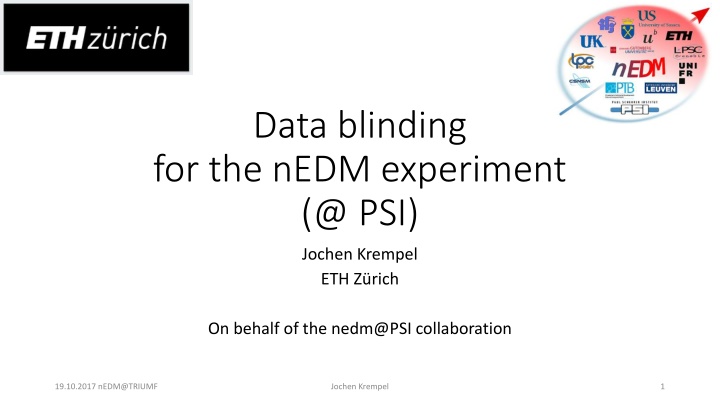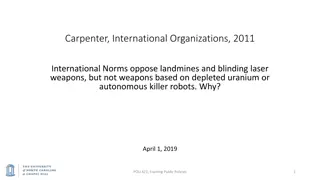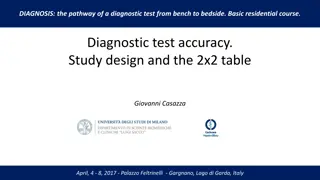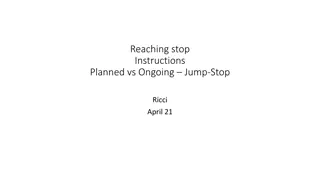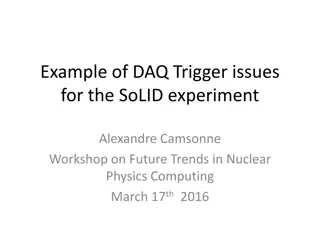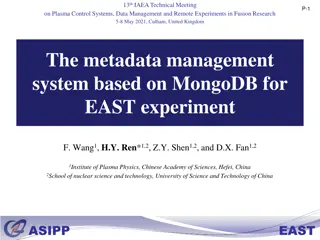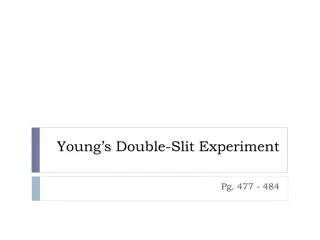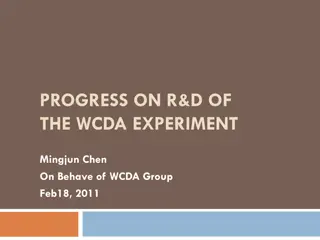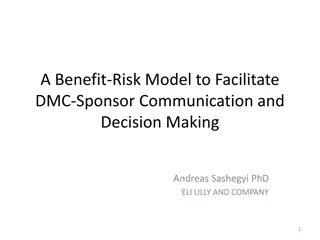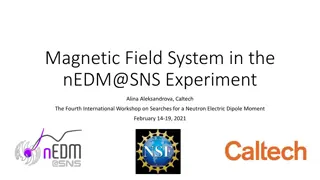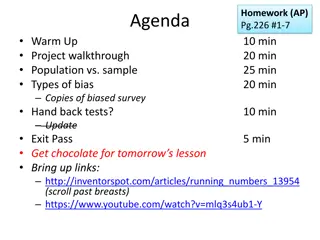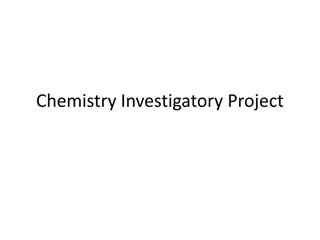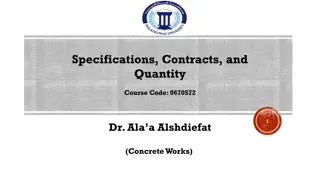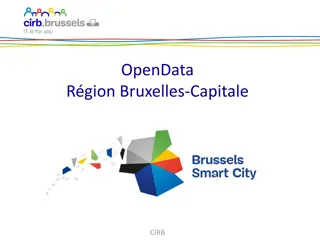Data Blinding for the nEDM Experiment at PSI
Data blinding is essential to avoid bias in the nEDM experiment. Learn about why blinding is challenging, methods for blinding, reblinding, and unblinding. Discover the significance of blinding offset and how it impacts precision measurements. Explore various blinding options and the complexities involved in neutron spin flip modifications. Understand the importance of blinding in particle physics experiments, and the critical role it plays in ensuring the integrity of research outcomes.
Download Presentation

Please find below an Image/Link to download the presentation.
The content on the website is provided AS IS for your information and personal use only. It may not be sold, licensed, or shared on other websites without obtaining consent from the author.If you encounter any issues during the download, it is possible that the publisher has removed the file from their server.
You are allowed to download the files provided on this website for personal or commercial use, subject to the condition that they are used lawfully. All files are the property of their respective owners.
The content on the website is provided AS IS for your information and personal use only. It may not be sold, licensed, or shared on other websites without obtaining consent from the author.
E N D
Presentation Transcript
Data blinding for the nEDM experiment (@ PSI) Jochen Krempel ETH Z rich On behalf of the nedm@PSI collaboration 19.10.2017 nEDM@TRIUMF Jochen Krempel 1
Outline Why blinding Why is blinding so difficult How do we blind Reblinding Unblinding 19.10.2017 nEDM@TRIUMF Jochen Krempel 2
Why blinding Avoid psychological bias during data analysis Experimenter s bias is defined as the unintended influence on a measurement towards prior results or theoretical expectations. Which cut to apply When to stop analysis/searching for bugs "We're more than one sigma from zero; we have to look at it some more, because we must be doing something wrong..." Outside reputation some secrecy is necessary, simply trusting everybody is not enough. promise to not look at result very low threshold. can be overcome to quickly (accidentally, or for sneaking) The human brain is quick. We do NOT protect against: Criminal energy, e.g. somebody installing spyware on DAQ computer arXiv:physics/0312102v1 Blind Analysis in Particle Physics Aaron Roodman JR Klein A Roodman BLIND ANALYSIS IN NUCLEAR AND PARTICLE PHYSICS Annual Review of Nuclear and Particle Science 2005 Vol. 55: 141-163 DOI: 10.1146/annurev.nucl.55.090704.151521 19.10.2017 nEDM@TRIUMF Jochen Krempel 3
Blinding offset The nEDM is a precision measurement with prior 0-value. need an blinding offset not blinding factor, neither fake events. In other words: nEDM measures value + uncertainty From that an upper limit is derived. We blind the raw data by shifting the value Blinding offset 19.10.2017 nEDM@TRIUMF Jochen Krempel 4
How do we blind? i / 19.10.2017 nEDM@TRIUMF Jochen Krempel 5
Various (not so good) options Modify frequency of neutron spin flip (synchronous to HV-polarity) blinding influences measurement (unknown systematic effects) impossible to remove or modify Write down a false spin-flip frequency Immediately visible in co-magnetometers Modify reading of magnetometers (Hg, Cs) DAQ sampling clock very delicate, and irreversible modify data Impossible to do consistently for Hg and Cs immediately visible 19.10.2017 nEDM@TRIUMF Jochen Krempel 6
How we blind i / 19.10.2017 nEDM@TRIUMF Jochen Krempel 7
How many neutrons to shift ? i / Simplified model: Actually the ordinate is Asymmetry, the abscissa is corrected with Hg-reading 19.10.2017 nEDM@TRIUMF Jochen Krempel 8
How many neutrons to shift II ? = 8000 ? = 0.65 sin?=0.99 T=180s E=10kV/cm Design Values (from 2014): ?? = 10 25? cm ?? , ,? 1.44 2016 max Values ? = 20000 ? = 0.75 sin?=0.95 T=180s E=11kV/cm ?? = 10 25? cm ?? , ,? 4.95 Rounding to nearest integer would limit granularity of blinding to multiples of 0.7 10-25 e cm Add first a Gaussian Random Variable (width 2) and then round. 2 is large enough to linearly map between location and arithmetic mean 2 is small enough to not add too much noise << sqrt(N) = 90 Note well: we do NOT use a Poisson distribution 19.10.2017 nEDM@TRIUMF Jochen Krempel 9
Blinding code Do a Ramsey fit, using: Neutron counts (asymmetry) Frequency of spin flip Hg-frequency and uncertainty E-field Sign of: B0 direction Detector configuration (spin-flipper 2) Spin-flipper 1 Obtain fit value of (and 0) per run ( 1 day). This can be done only after the run has been completed! For each cycle icalculate mean number to be shifted . Initialise random generator; add Gaussian noise and round. For each cycle i, select Ni neutrons randomly. Change their detector flag. = convert them from up to down (or vice versa). 08.02.2016 BVR Jochen Krempel 10
Something changed Original idea: N and are fitted per run (~1day) Based on 2014 data First 2015 data showed: Much more neutrons, but decreasing within a run Cannot use ? Use ? ,?+ ? ,? instead Adds noise, but much less than natural counting statistics 19.10.2017 nEDM@TRIUMF Jochen Krempel 11
Online blinding Want Count numbers immediately for health check. Blinding not yet available (missing ) Online blinding with a separate offset randomly chosen for each run i / Online Ramsey-fit for gradient compensation done only at E=0, thus no blinding. 19.10.2017 nEDM@TRIUMF Jochen Krempel 12
Re-blinding if we ever find a bug in the blinding algorithm we can re-blind previously blinded data stays public (but it is advised to not use them) additional data files (new blinding code) are published 08.02.2016 BVR Jochen Krempel 13
Reblinding (how) Reblinding uses the same (secret) offset (we can change if we want to, but we MUST keep the same sign) Algorithm to chose UCNs for shifting (randomly): the random number generator is initialized: freshly for each cycle. based on entropy only taken from this cycle. one cycle will have for various blindings always about the same n neutrons shifted. works fine (does not reveal anything), - but only if difference to previous blinding is not so large - and for sure: no sign change!!! quite some effort to develop this method (especially to be sure to not have messed it up) 08.02.2016 BVR Jochen Krempel 14
Secondary blinding / east-west 2 independent analysis groups (east, west) Primary blinding on raw data (common) Secondary blinding EAST on top of primary same algorithm / different offset Secondary blinding WEST on top of primary same algorithm / another different offset raw data is kept secret primary data is kept secret eastern data published to eastern people (and not to western) western data published to western people (and not to eastern) 300 GB /year / blinding 08.02.2016 BVR Jochen Krempel 15
Teething troubles Cycles with 0 counts suddenly got negative counts (online blinding) Decrease of neutron number during cycle Non-edm use case required new exceptions 19.10.2017 nEDM@TRIUMF Jochen Krempel 16
Positive side effect There is now an EDM in the data. Thus the sign and the magnitude becomes important. blinding helps to get your analysis correctly (because bugs are visible) 19.10.2017 nEDM@TRIUMF Jochen Krempel 17
Who knows blinding offset Graph by G. Bison NO human Blinding program needs to know it Randomly generate offset, store it encrypted using a public key private key is injected into blinding program during compile process Blinding offset is never written in clear text (nobody can accidentally read it) Blinding code can be modified at any time and recompiled one trustful person necessary to maintain the private key Blinding offset / 10-26 e cm 19.10.2017 nEDM@TRIUMF Jochen Krempel 18
Timeline January 17 2015: Formation of Blinding Task group March: Concept April - July: Implementation of dummy code Test on last years data implementation of real code tests with first UCNs, bug fixing August: blinded data taking, but not secret, bug fixing September 10 2015: change to new, secret blinding offset Implement secondary blinding and re-blinding February 2016: Release blinded data of 2015 Since then automatic blinding of most runs. 19.10.2017 nEDM@TRIUMF Jochen Krempel 19
Performance (2015+2016) 1072 runs with data files from neutron detector 113 runs automatically blinded 14 runs needed manual blinding 20 runs needed manual revealing Problems caused by: In 2015: mainly software problems (e.g. SpinFlipper state) In 2016: mainly heavy drifts of magnetic field. 19.10.2017 nEDM@TRIUMF Jochen Krempel 20
How to unblind 19.10.2017 nEDM@TRIUMF Jochen Krempel 21
What to do before unblinding Wait until analysis is close to statistical limit All systematics have been analysed The paper has been written Define discrepancy limit 19.10.2017 nEDM@TRIUMF Jochen Krempel 22
extending to n2EDM double chamber, accurate Cesium sensors, Ramsey-sine --> need new fit models Maybe add online gradient estimation --> need some data for tuning threshold parameters Extending to other experiments Fine, as soon as they do have a simultaneous spin analyser. 3He as detector: needs a bit investigation how to shift counts. 19.10.2017 nEDM@TRIUMF Jochen Krempel 23
Summary successful blinding Blinding offset unknown to all humans Blinding secured by strong encryption + some enforcement rules unblinding still upcoming can be used for 2nd phase blinding should be anticipated in early stage of DAQ-design final implementation only possible when knowing the performance of the apparatus 19.10.2017 nEDM@TRIUMF Jochen Krempel 24
http://xkcd.com/1462/ Thanks Phil Harris (U Sussex) Concept / maths / pushing people Yoann Kermaidic (LPSC Grenoble) code Ramsey fitting / testing Jacek Zemja (JU Krakow) code main DAQ Nick Ayres (U Sussex) maths Elise Wursten (KU Leuven) analysis / testing Thomas Lefort, Jean Hommet, Yves Lemiere (LPC Caen) code neutron shifting JK (ETH Z rich) concept / design / code review / code merging / testing 19.10.2017 nEDM@TRIUMF Jochen Krempel 25
Backup Slides 19.10.2017 nEDM@TRIUMF Jochen Krempel 26
Unblinding with 2 analysis groups Not decided yet Possible Option: As soon as both analysis group get below the same error (and close to irreducible statistical uncertainty) unblind secondary blinding Run analysis code on unblinded data, compare to blinding offset if happy (predefined Boolean expression), unblind primary blinding Final result will be analysis code on raw data, But hopefully in agreement with analysis on blinded data minus blinding offset Blinding on Toy-data 08.02.2016 BVR Jochen Krempel 27
Secrecy of data files Raw data (secret) + blinded data (public) Backup scheme: Slow control France PSI -AFS Intern PSI Main DAQ PSI tape Neutron GRID Poland Encrypt secret data with RSA (asymmetric) Use public key for encryption Private key is kept in sealed envelope Do not trust encryption -> keep additional copy (NOT encrypted) at hidden place 19.10.2017 nEDM@TRIUMF Jochen Krempel 28
BACKUP Secrecy for data files Step 0) Get their public key openssl rsa -in id_rsa -pubout -outform pem > id_rsa.pub.pem Step 1) Generate a 256 bit (32 byte) random key openssl rand -base64 32 > key.bin Step 2) Encrypt the key (asymmetrically) openssl rsautl -encrypt -inkey id_rsa.pub.pem -pubin -in key.bin -out key.bin.enc Step 3) Actually Encrypt our large file (symmetrically) openssl enc -aes-256-cbc -salt -in SECRET_FILE -out SECRET_FILE.enc -pass file:./key.bin Step 4) Put key.bin.enc and SECRET_FILE.enc to Archive Decryption (in 2 years) openssl rsautl -decrypt -inkey id_rsa.pem -in key.bin.enc -out key.bin openssl enc -d -aes-256-cbc -in SECRET_FILE.enc -out SECRET_FILE -pass file:./key.bin 19.10.2017 nEDM@TRIUMF Jochen Krempel 29
BACKUP RSA algorithm https://de.wikipedia.org/wiki/RSA-Kryptosystem Calculate private key Chose 2 large prime numbers p = 11 and q = 13 RSA-Modulus is N = p * q = 143 Euler's totient function phi(N) = phi(143) = (p-1)(q-1) = 120 Chose e coprime to 120. We chose e = 23. e = 23 and N = 143 are the public key. Calculate public key (Inverse of e): e * d + k * phi(N) = 1 = ggT(e,phi(N)) (Greates Common Divisor) 23 * d + k * 120 = 1 = ggT(23,120). Extended Euclidean algorithm d=47 and k=-9 23 * 47 + (-9 )* 120 = 1 d=47 is the secret key, k can be disposed encryption m=7 with public key (e,N) (m < N) c = m ^ e mod N 7 ^ 23 mod 143 = 2 decrypt m = c ^ d mod N 2 ^ 47 mod 143 = 7 19.10.2017 nEDM@TRIUMF Jochen Krempel 30
Why blinding II Extreme Example: Imagine you unblind your data and get: 6.0 e-26 e cm +- 1e-26 e cm 6 sigma from zero = clear discovery 2 sigma from previous measurements. What do you do? Publish If you re-analyse before publishing, then you MUST mention the original result additionally. 19.10.2017 nEDM@TRIUMF Jochen Krempel 31
